Featured This Month
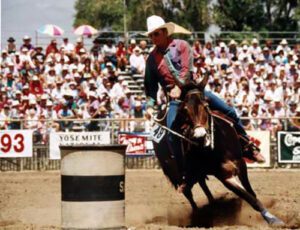
MULE CROSSING: Surge of Mule Shows
All Articles
MULE CROSSING: The Language of Longears
By Meredith Hodges
Many of you know me as the foremost authority on the contemporary saddle mule, but what you may not know is how I earned such a title. Most of us who have become trainers began by riding and showing. Through our success, we gained recognition and subsequently clients who brought their animals to us for training. Our success with their animals posed a question for each of us at a critical stage in our careers and we had to make a decision whether we were going on the road to do clinics or something different. I opted for something different!
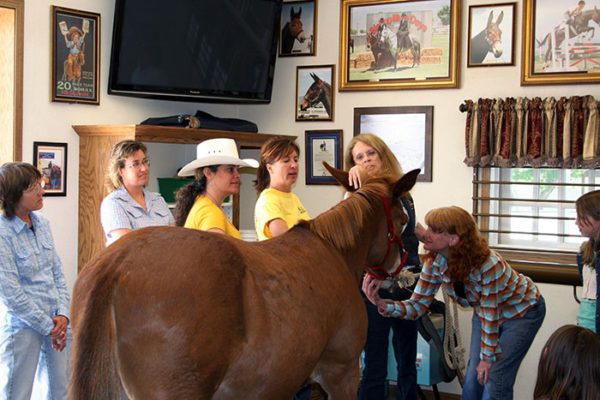 Instead of going on the road to do clinics, I thought long and hard and decided to do an equestrian correspondence training course instead. I opted for this after considering that when I went to clinics as a student, I was one of 20 people and only got limited attention during those clinics. When I put into practice at home what I had learned at the clinics, I realized that I had only received the highlights of training and it was full of holes! When I tried to contact the clinicians to ask a question, I was either answered by someone in the office, or not answered at all. The clinicians were most often too busy and out of touch. The one thing I didn’t realize by making this decision was the incredible learning opportunity I had opened up for myself that I could, in turn, pass on to my clients.
Instead of going on the road to do clinics, I thought long and hard and decided to do an equestrian correspondence training course instead. I opted for this after considering that when I went to clinics as a student, I was one of 20 people and only got limited attention during those clinics. When I put into practice at home what I had learned at the clinics, I realized that I had only received the highlights of training and it was full of holes! When I tried to contact the clinicians to ask a question, I was either answered by someone in the office, or not answered at all. The clinicians were most often too busy and out of touch. The one thing I didn’t realize by making this decision was the incredible learning opportunity I had opened up for myself that I could, in turn, pass on to my clients.
I did my resistance-free video training series in as much detail as I could possibly muster. Each video represents a year’s worth of training, but as we all come to know, you can never know everything. The more you learn, the more you learn what you don’t know. I did learn fairly quickly that the relationship between equine and owner is unique to those individuals. That is, I realized it made more sense that I teach people how to train their own animals. After all, you wouldn’t ask someone to go out and make a friend for you? The relationship is truly your own and I adopted the policy that as a trainer, my responsibility would be to guide people through the process of training their own animals for the best possible results. This has proven to be true far beyond any expectations that I might have had!
This decision afforded me more time at home where I could communicate with others and help them with their animals. It also afforded me more training time with my 30 head of mules, horses and donkeys. I have always done the training of my own animals myself. I had an assistant for awhile who kept the old school masters and other broke mules exercised from time to time. However, the actual training of the mules I did solely by myself because I wanted to keep learning new things that would enhance my training program and make it better. The new things I learned I documented in the form of books, videos and television shows. What began as a quest to train and show mules in every equestrian discipline expanded beyond my wildest dreams!
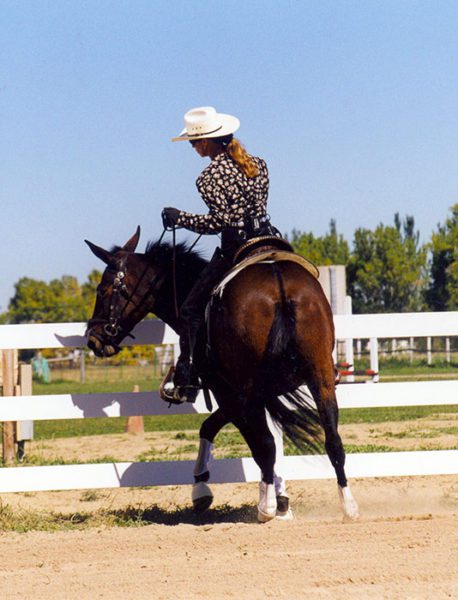 When they told me mules would not work well in a snaffle bit, I learned how to make that work. When they said they were not suitable for Dressage, I based my entire training program on those principles. When they told me not to give food rewards, I paid my mules for their efforts with a generous reward of crimped oats. When they told me not to talk to my equines, I spoke three languages to them: verbal language, body language and “touch” language. I can truthfully say that today I realize that it wasn’t the mules that were so stubborn, but rather…it was me! This positive kind of stubbornness did pay off, as I was to soon discover.
When they told me mules would not work well in a snaffle bit, I learned how to make that work. When they said they were not suitable for Dressage, I based my entire training program on those principles. When they told me not to give food rewards, I paid my mules for their efforts with a generous reward of crimped oats. When they told me not to talk to my equines, I spoke three languages to them: verbal language, body language and “touch” language. I can truthfully say that today I realize that it wasn’t the mules that were so stubborn, but rather…it was me! This positive kind of stubbornness did pay off, as I was to soon discover.
Beginning with the “A B C’s” (walk, trot, canter, whoa, back), my verbal language with them evolved over time into actual conversations. The tone of my voice indicated my pleasure or displeasure with their actions. Calling their names and then stating a command prompted their immediate attention. When working with multiple animals, phrases like “Get back on the rail!” and “Stop kicking your brother!” initiated a positive response and validated my expectations that they could indeed understand what I was saying beyond the normal commands. I watched their reactions to the tour guests we had at the ranch as they walked through the barn and met these animals. If a guest made a remark, the animals responded with an appropriate show of emotion. If it was a snide remark, they would lower their heads and splay their ears in a most dejected way. A positive remark would elicit a show of attention with ears perked toward the person who made the comment. This has shown me that they do understand English, even if they cannot speak it!
Body language is probably the most important of all the “languages.” These animals will mirror you and react to what your body is telling them. If you position yourself in front, you can turn them or stop them. If you walk up to them in an aggressive way, they will show fear. If you go to a gate or the stall door and wait with an inviting attitude, they will come to you. Of course, learning accurate body language is a responsibility that we must put upon ourselves to really be effective. I just watched the reactions of my animals to everything I did and said. If I received a negative response, I would change my approach until I got it right. When I got it right, so did they!
“Touch” language is simply how you touch your animal whether it is with your hand, a grooming tool or a whip. Touch needs to be empathetic but firm enough to do the job. Touch is a powerful tool. It can be soothing and relieve anxiety. It can be pleasurable or painful. Touch can indicate direction depending on how it is used. We begin with imprinting, or touching of the foal all over its body, but this is not the beginning and end of imprinting. Imprinting sets the stage for the kind of interaction you and your equine will have during your entire life together and can often bridge a gap of misunderstanding when the other two languages are not working. Never was this more apparent to me than just recently!
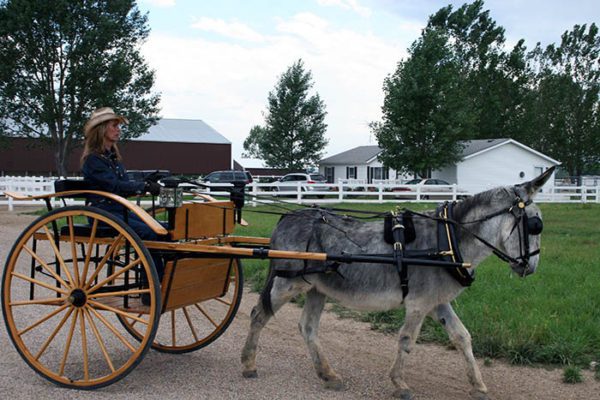 Little Jack Horner had gone through my entire training series right along with my mules and had learned everything that I taught them. He may not have made it to Fourth Level Dressage, but he made it to Second Level Dressage with gait lengthening and lateral work. He overcame his “donkey” behaviors and gave a phenomenal performance, jumping four feet in exhibition at Bishop Mule Days. His Reining was accurate though somewhat limited by his donkey conformation. Still, he could always elicit a supportive laugh and a wide grin! He competed successfully at dressage driving shows and won world championships in driving at Bishop Mule Days.
Little Jack Horner had gone through my entire training series right along with my mules and had learned everything that I taught them. He may not have made it to Fourth Level Dressage, but he made it to Second Level Dressage with gait lengthening and lateral work. He overcame his “donkey” behaviors and gave a phenomenal performance, jumping four feet in exhibition at Bishop Mule Days. His Reining was accurate though somewhat limited by his donkey conformation. Still, he could always elicit a supportive laugh and a wide grin! He competed successfully at dressage driving shows and won world championships in driving at Bishop Mule Days.
Little Jack Horner was to star yet again in the making of my biography, our latest Those Magnificent Mules documentary project. I doubt that I had driven Little Jack Horner in fifteen years. In fact, since he turned twenty, he had not done much but take part in more sedate roles in our TV shows and videos with an occasional bareback ride around the ranch. At 30 years old, I wasn’t really sure how he would react to being hitched to the Meadowbrook cart again after so many years, so I thought I had better do a dress rehearsal.
During the dress rehearsal, I discovered that Little Jack Horner didn’t know what to do once I put on the harness. He was tied in the tack barn and when I tried to ground drive him forward, he just backed up until he was out of the building, then he went forward to the hitching area. I was rather puzzled. Still, I went ahead and hitched him to the cart and we stood there for some photos before I backed him from the hitch rail. I verbally asked him to go forward…nothing. I did not have my driving whip with me, so I used the end of the reins on his fanny to move him forward which he then did, but kept going straight until he ran into the fence and stopped.
I thought this was very strange, so I asked my ranch manager to get my driving whip. With the whip in hand, I began to talk to him with the whip. A simple tap to the side and he turned from the fence. Another tap in the middle of his spine sent him smartly forward at an animated walk. Another tap to the other side turned him the other way and we were soon doing figure eights, stopping, backing and driving as if there was never a problem at all. During the film shoot, he did all these things and even offered several hundred feet of trot before he was too tired to continue.
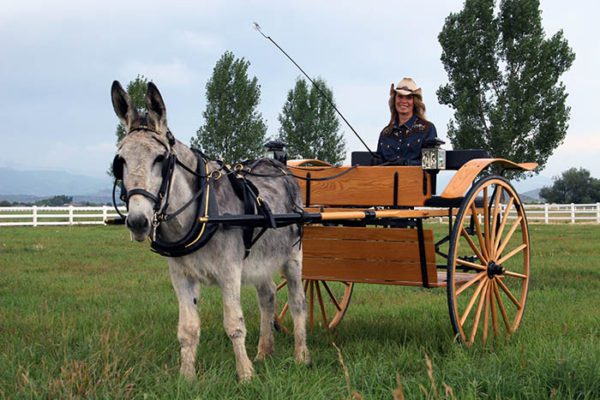 It was during this experience that I realized that Little Jack Horner had become deaf and could not hear one word of what I was saying, even when I was yelling. I was sitting in the Meadowbrook cart, he had blinders on his harness bridle and could not see me, so verbal language and body language were of no help to him at all. Lucky for us, we still had the “touch” language that we had developed between us and we thoroughly enjoyed the experience of driving yet again.
It was during this experience that I realized that Little Jack Horner had become deaf and could not hear one word of what I was saying, even when I was yelling. I was sitting in the Meadowbrook cart, he had blinders on his harness bridle and could not see me, so verbal language and body language were of no help to him at all. Lucky for us, we still had the “touch” language that we had developed between us and we thoroughly enjoyed the experience of driving yet again.
It is evident to me that every detail that I had taken the time to learn in our 30-plus years together culminated in the results I see now with all of my equines. We have learned so much about each other! Now that we are all a lot older, a lot slower and a lot less coordinated, we are still afforded the luxury to continue to learn and grow together in a safe and enjoyable way. It doesn’t get any better than this!
To learn more about Meredith Hodges and her comprehensive all-breed equine training program, visit LuckyThreeRanch.com, MEREDITH HODGES PUBLIC FIGURE Facebook page, or call 1-800-816-7566. Check out her children’s website at JasperTheMule.com. Also, find Meredith on Pinterest, Instagram, MeWe, YouTube and Twitter.
© 2010, 2011, 2016, 2019, 2024 Lucky Three Ranch, Inc. All rights reserved.
MULE CROSSING: Choosing the Right Jack
By Meredith Hodges
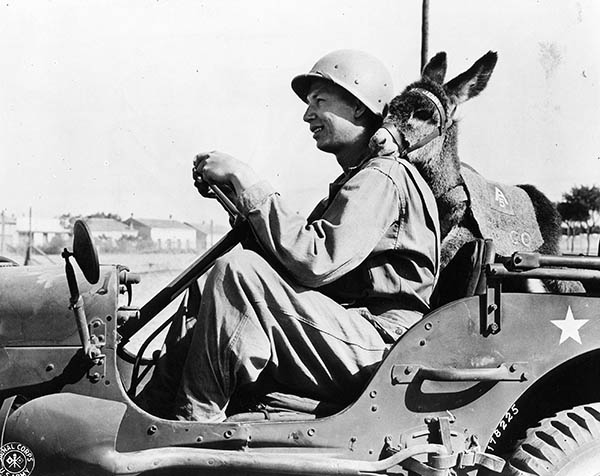 When choosing a jack to breed to your mares and jennets, there are many important factors to consider. Conformation is the most obvious, but size, type, disposition and genetics are equally significant. As a direct result of the donkey’s evolution our choices in jacks are considerably limited these days. In the days when donkeys were widely used as beasts of burden, conformational soundness was an important consideration in their ability to do physical work. Today, the donkey is not as widely used in this manner, becoming more of an owner’s pleasure animal. In some cases, he is simply another pet. As a result, not much care has been taken to preserve his conformational integrity, thus limiting the availability of true breeding stock.
When choosing a jack to breed to your mares and jennets, there are many important factors to consider. Conformation is the most obvious, but size, type, disposition and genetics are equally significant. As a direct result of the donkey’s evolution our choices in jacks are considerably limited these days. In the days when donkeys were widely used as beasts of burden, conformational soundness was an important consideration in their ability to do physical work. Today, the donkey is not as widely used in this manner, becoming more of an owner’s pleasure animal. In some cases, he is simply another pet. As a result, not much care has been taken to preserve his conformational integrity, thus limiting the availability of true breeding stock.
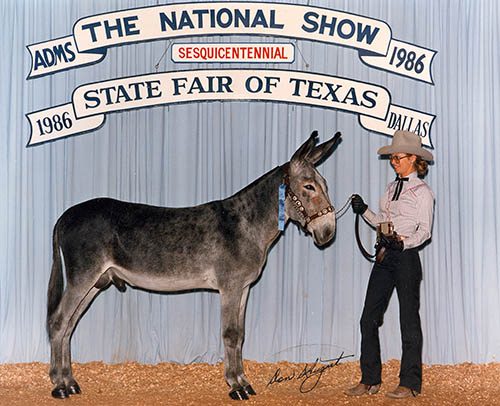 Although the conformation of the ideal jack can only be approximated, you should always try to choose a jack that is as close to the ideal as possible for your breeding programs. (Perpetuating undesirable conformation traits will only compound future breeding problems.) The first conformational consideration is the jack’s overall balance and proportion. His torso should be well connected to the front and rear quarters, with plenty of width and depth from heart girth to the flank, which allows for maximum efficiency of the heart and lungs. The topline from the withers to the tail should be relatively straight, with only a gentle slope from the withers to the croup, and neither excessively long nor short-backed. A longish back is acceptable, provided there is not a lot of distance between the last rib and the point of the hip, as this causes weakness through the loins. The unusually short-backed jack does not have adequate lateral and vertical flexibility in his movement. A rigidly straight back is discouraged, as is a back that sags too drastically in the middle (except in the case of an aged animal).
Although the conformation of the ideal jack can only be approximated, you should always try to choose a jack that is as close to the ideal as possible for your breeding programs. (Perpetuating undesirable conformation traits will only compound future breeding problems.) The first conformational consideration is the jack’s overall balance and proportion. His torso should be well connected to the front and rear quarters, with plenty of width and depth from heart girth to the flank, which allows for maximum efficiency of the heart and lungs. The topline from the withers to the tail should be relatively straight, with only a gentle slope from the withers to the croup, and neither excessively long nor short-backed. A longish back is acceptable, provided there is not a lot of distance between the last rib and the point of the hip, as this causes weakness through the loins. The unusually short-backed jack does not have adequate lateral and vertical flexibility in his movement. A rigidly straight back is discouraged, as is a back that sags too drastically in the middle (except in the case of an aged animal).
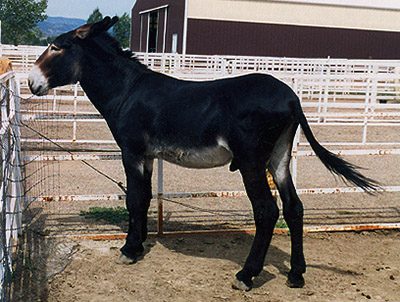 Proportionately, the jack should not be too narrow in the chest, through the rib cage and in the rear quarters—nor should he be too wide in these areas. These faults in proportion can interfere with his action, causing him to be “pin-toed” (splay-footed) or “pigeon-toed” (toed-in). The pin-toed jack will brush his knees and fetlocks together in deep footing, causing him to be a slow mover, or he may even cross his legs over one another, increasing the possibility of a fall.
Proportionately, the jack should not be too narrow in the chest, through the rib cage and in the rear quarters—nor should he be too wide in these areas. These faults in proportion can interfere with his action, causing him to be “pin-toed” (splay-footed) or “pigeon-toed” (toed-in). The pin-toed jack will brush his knees and fetlocks together in deep footing, causing him to be a slow mover, or he may even cross his legs over one another, increasing the possibility of a fall.
The closest approximation to a 45-degree angle in the hips and shoulders is preferred, with an adequate balance of muscle and sinew in all four quarters. One of the most common faults in donkeys today is straight and slight shoulders and hips. The withers and croup should be even across the topline, and the jack with withers slightly higher than the croup is preferred over the opposite, as this could set 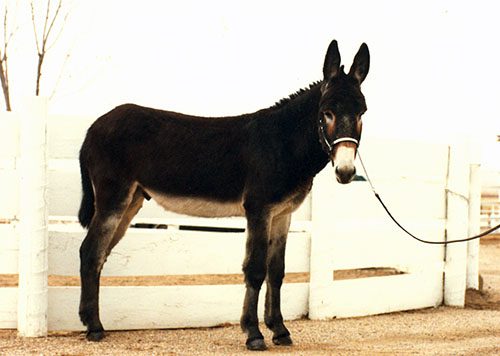 the animal’s body weight too far on the forehand, making turns and stops more difficult. It could also increase the possibility of falling. The croup should be smooth and round over the rump, with a tail set neither too high nor too low.
the animal’s body weight too far on the forehand, making turns and stops more difficult. It could also increase the possibility of falling. The croup should be smooth and round over the rump, with a tail set neither too high nor too low.
The feet and legs of the jack are the foundation of his conformation. They should be straight and true, with flat bone and adequate angles at the shoulders, hips, stifles, and hock and fetlock joints. The foot should be trimmed and shaped to compliment the angles in his joints to maintain the good conformation that should be present in the four quarters of the animal. For example, on a jack with good shoulders, the slope of the pasterns should be parallel to the slope of the shoulders. When dropping a plumb line on the front legs, which should be neither too far forward nor too far underneath him, the plumb line should fall from the point of the withers to the ground, directly at the back of the front legs. When dropping a plumb line on the hind legs, it should fall from the base of the tail to the point of the hock, and straight down the back of the cannon bone to the ground.
As far as a donkey’s hoofs are concerned, the expression, “No foot, no donkey” is literally true. Faults such as buck-kneed, calf-kneed, tied-in at the knee, round bone, short straight pasterns, coon-footed, too-long cannon, sickle hocks, splay-footed, knock-kneed, bowlegged, pigeon-toed, broken forward or backward feet, or too straight through the stifle and hock are all serious faults and should be avoided when breeding. Being slightly cow-hocked behind can be overlooked, as this usually increases maneuverability. The hoof itself should not reflect a ribbed appearance — it should be smooth and inclined to look sleek and oily. Even on the donkey, the hooves should not be contracted, but well-sprung (although less sprung than a mule or horse), and supported with a well-extended, healthy frog. Donkeys have a multi-layered hoof wall that will shed off in the event of mild or even severe trauma to the coronet or hoof wall, so many donkeys exhibit a “peeling” or “scabbing” of the hoof wall. A jack with this damage to the hoof should be inspected carefully to determine the severity of the problem and the extent of 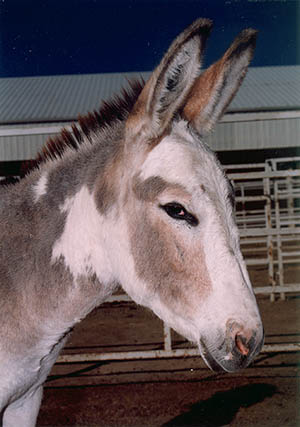 possible weakness in the hoof itself. If it is a cosmetic problem, it can often be managed successfully by adding one ounce a day of Mazola corn oil to the diet. If it is a genetic problem, a jack with hoof problems should be avoided when breeding and should probably be castrated.
possible weakness in the hoof itself. If it is a cosmetic problem, it can often be managed successfully by adding one ounce a day of Mazola corn oil to the diet. If it is a genetic problem, a jack with hoof problems should be avoided when breeding and should probably be castrated.
The head and neck of the ideal jack should be attractive and set-in correctly, giving an overall balanced look to the animal. He should have good length to the ears, neither too far forward nor too far back, so the poll is clearly apparent. His eyes should be set so they give him a maximum field of vision forward, backward and peripherally. The eyes should not be set too high nor too low, which would offset the overall balance of the head. He should have adequate width and fine enough bone in the head, to allow for plenty of space for the brain and internal organs of the scull cavity. The length of his head should compliment the balance of his body and taper to a smaller and delicate muzzle. His jaw should be straight and aligned, showing neither a parrot mouth (under bite), nor be undershot (over bite, or buck toothed). This is critical for feeding and nutrition. The slightly dished-face, straight-faced or Roman-nosed jack should not be ruled out, provided the other criteria are met. The neck should be set in so that it flows easily into the withers and has adequate length for the ability to bend and maintain balance. He should have neither a U-neck nor an excessively crested neck. It should not be too wide, or too narrow, and should tie into the throatlatch in a trim and flexible way.
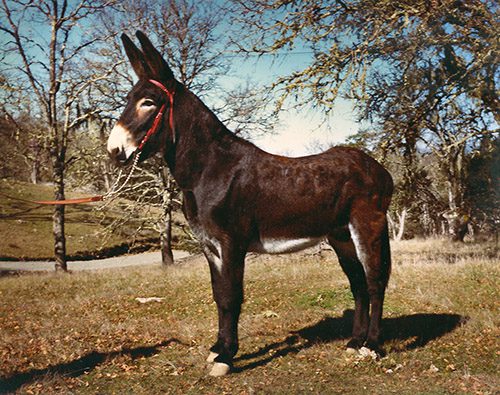 The basic conformation for the breeding jack should be the same regardless of size, although there are specific considerations with regard to type and use. The jack generally contributes more to the thickness of bone in his offspring, but not necessarily to their height. Therefore, when breeding for saddle mules and donkeys, the more refined-boned Standard or Large Standard jacks are preferred. On the other hand, when breeding for a draft mule or donkey, you would want to preserve more thickness of bone and use a stockier jack, such as a Large Standard or Mammoth. Use the same guidelines when breeding for miniatures; stocky begets stocky and refined begets refined. When breeding for saddle mules, you may want to keep the refinement, so you would use a Standard or Large Standard jack to breed to a saddle horse mare. However, if you wish to have a pack mule that is not overly tall, you might then want to breed a Mammoth jack to a saddle horse mare.
The basic conformation for the breeding jack should be the same regardless of size, although there are specific considerations with regard to type and use. The jack generally contributes more to the thickness of bone in his offspring, but not necessarily to their height. Therefore, when breeding for saddle mules and donkeys, the more refined-boned Standard or Large Standard jacks are preferred. On the other hand, when breeding for a draft mule or donkey, you would want to preserve more thickness of bone and use a stockier jack, such as a Large Standard or Mammoth. Use the same guidelines when breeding for miniatures; stocky begets stocky and refined begets refined. When breeding for saddle mules, you may want to keep the refinement, so you would use a Standard or Large Standard jack to breed to a saddle horse mare. However, if you wish to have a pack mule that is not overly tall, you might then want to breed a Mammoth jack to a saddle horse mare.
The genetic pool is a very important consideration when breeding. A particular jack may be a beautiful specimen, but, regardless of how lovely and balanced he may be, he may possess genes that produce offspring with many conformation faults. Since donkeys have been so inbred, this can happen more frequently than you might imagine. When choosing a jack to breed to your mares and jennets, it is wise, if possible, to take a look at some of his offspring from different mares and jennets, so you can better assess his stronger traits and determine which traits appear to be pre-potent. If this is not possible, your alternative is to breed him with only the best mare or jennet you own, in order to increase the odds for positive traits to come through in the offspring. Sometimes you can try to compliment the mare with the jack, such as a long-backed mare with a short-backed jack to get a medium-backed mule, but this doesn’t always work. A reputable jack owner should have records to show how and what his jack has produced and be able to attest to the consistency of his jack’s production. Granted, in the past this was virtually impossible, but today we have the American Donkey & Mule Society registry (and other Longears registries), and many conscientious breeders who realize the importance of recording their breeding 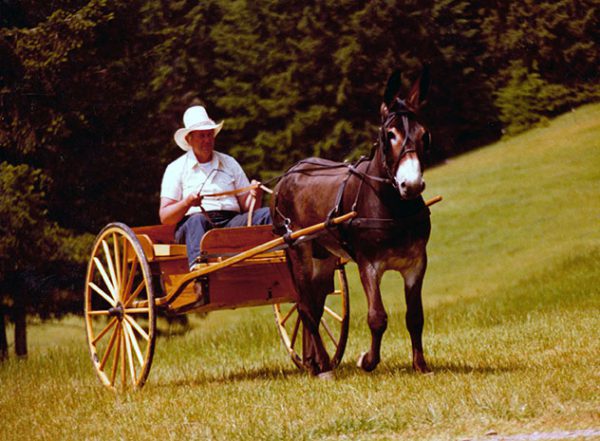 information, thereby giving us all a better understanding of Longears production. So, don’t be afraid to ask the breeder whatever questions you may have.
information, thereby giving us all a better understanding of Longears production. So, don’t be afraid to ask the breeder whatever questions you may have.
Disposition is of the utmost importance when choosing a jack. However, there is a difference between the jack’s natural instincts, his personality and his acquired personal attitudes, so you should learn to distinguish between a natural instinct, a distinctive personality trait and behavior that was the result of improper handling. I have found most donkeys to be quite cooperative and affectionate when patiently and fairly treated, but some can also be more obstinate about things than others. Remember, in addition to the inherited traits of the jack, it is the mare, or jennet, from which the offspring learns most of his behaviors while he is growing up. So learn to make educated choices concerning your breeding stock and, in order to maintain the integrity of the breed, use only jacks with the best conformation for breeding.
To learn more about Meredith Hodges and her comprehensive all-breed equine training program, visit LuckyThreeRanch.com, MEREDITH HODGES PUBLIC FIGURE Facebook page, or call 1-800-816-7566. Check out her children’s website at JasperTheMule.com. Also, find Meredith on Pinterest, Instagram, MeWe, YouTube and Twitter.
© 1986, 1991, 2012, 2016, 2020, 2021, 2022, 2024 Lucky Three Ranch, Inc. All Rights Reserved.
——–
Photo Captions:
1) North Africa 1943 (Library of Congress)
2) Sire-Supreme Little Jack Horner and Meredith Hodges
3) Lucky Three Excalibur
4) Lucky Three Blue Baron
5) Standard Jack, Colorado D.J.
6) Foundation Sire Windy Valley Adam
7) Don Mode driving Foundation Sire Black Bart
MULE CROSSING: Donkey Jacks
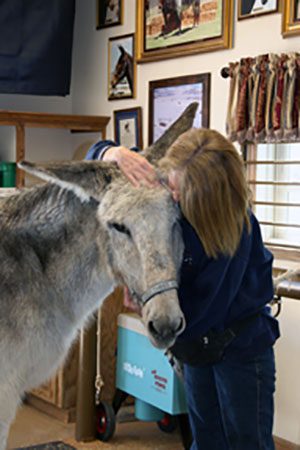 By Meredith Hodges
By Meredith Hodges
A donkey jack can be your best friend or your worst enemy! Because he is a donkey, he possesses all the wonderful characteristics particular to donkeys—intelligence, strength, easy maintenance, suitability for many equine sports and, probably most important, an innate affectionate attitude. You must, however, realize that he is still an intact male, often governed by the hormones in his body. When nature takes over, the jack’s conscious thought is greatly diminished and he can become quite hazardous to your health. The jack’s aggressiveness is often masked by his sedate and affectionate attitude, but it can arise in a split second and do more damage than even a stallion. Usually, there is an awkwardness, or indecisiveness, in an agitated stallion that will allow you time to get out of the way, but the jack reacts strongly, swiftly and right on target, allowing you little or no time for retreat. By keeping a few simple things in mind, you can greatly reduce your chances of injury when handling jacks.
First, try to keep your jack in a comfortable atmosphere. Jacks can be great worriers, particularly about their mares and jennets. Ideally, you should keep the jack well out of sight and smell of the females, but this is not always practical. If he must be near females, make sure your jack has a roomy area, free of 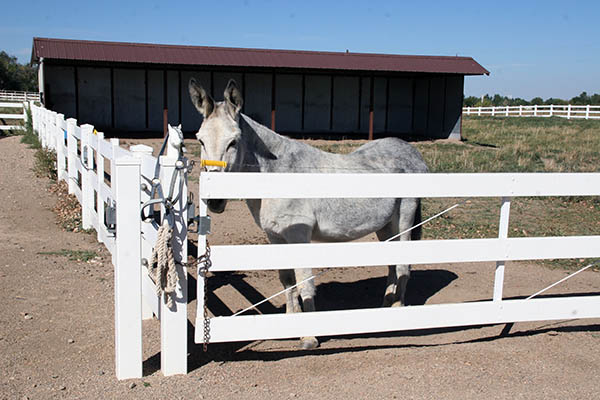 refuse and debris, and adequately fenced. The fences should be high enough to discourage his leaning over the top and strong enough to bear his weight on impact. Also, they must be constructed so that there are no protrusions that could cause him injury. If females (or other animals) are present, the jack may run back and forth along the fence and catch his head on anything that is protruding. Hot wires along the inside of a weaker fence will often serve this purpose. However, a hot wire used alone is not sufficient. If your jack becomes frightened, he could run through an electric wire before he even knows that it is there. Giving him a clean, comfortable area where his limits are clearly defined will help him to be a calmer and more manageable animal.
refuse and debris, and adequately fenced. The fences should be high enough to discourage his leaning over the top and strong enough to bear his weight on impact. Also, they must be constructed so that there are no protrusions that could cause him injury. If females (or other animals) are present, the jack may run back and forth along the fence and catch his head on anything that is protruding. Hot wires along the inside of a weaker fence will often serve this purpose. However, a hot wire used alone is not sufficient. If your jack becomes frightened, he could run through an electric wire before he even knows that it is there. Giving him a clean, comfortable area where his limits are clearly defined will help him to be a calmer and more manageable animal.
Always make sure your jack’s pen is cleaned daily and that he has free access to clean water, a trace mineral salt block and good grass hay. If he gains too much weight with free choice grass hay, then simply limit his intake to two flakes at each feeding in the morning and evening. He can have a limited amount of oats during one feeding a day (preferably in the evenings), mixed with an appropriate vitamin supplement such as Sho Glo, and one ounce of Mazola corn oil (I suggest this particular brand—other brands of corn oils are not the same) for management of his coat, his feet and his digestive tract regularity. During feeding times, you should check him from top to bottom for any new changes to his body like cuts, bruises, lameness, etc. This is also a good way to reinforce his acceptance of being handled all over and to solidify your relationship with him. This consistent management practice paves the way for good manners in the jack, because he then knows with no uncertainty that you are a true friend and really do care about his well-being.
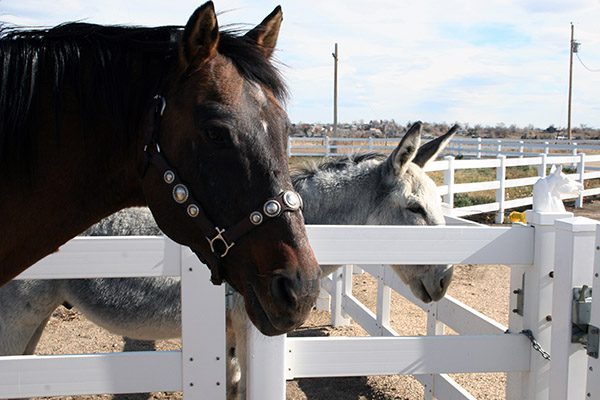 Many people opt to keep jacks in solitude, but this is not really good for them. Being a natural herd animal, they need social interaction. When they don’t have company nearby, jacks can become depressed (donkeys have actually been known to die from depression—they can stop eating and simply give up). To remedy this, jacks can be pastured or penned next to other animals, as long as the fencing is adequate between them. Of course, you also need to take into consideration the personality types of the animals involved, as well as being careful to make sure they are compatible. This can fulfill their need for companionship and keep them happy in confinement. As long as there are no cycling horse or donkey females around, jacks can be pastured next to mules of both genders. I had my own jack, Little Jack Horner, penned next to our teaser stallion for many years and they actually liked each other! We never had any trouble with them at all.
Many people opt to keep jacks in solitude, but this is not really good for them. Being a natural herd animal, they need social interaction. When they don’t have company nearby, jacks can become depressed (donkeys have actually been known to die from depression—they can stop eating and simply give up). To remedy this, jacks can be pastured or penned next to other animals, as long as the fencing is adequate between them. Of course, you also need to take into consideration the personality types of the animals involved, as well as being careful to make sure they are compatible. This can fulfill their need for companionship and keep them happy in confinement. As long as there are no cycling horse or donkey females around, jacks can be pastured next to mules of both genders. I had my own jack, Little Jack Horner, penned next to our teaser stallion for many years and they actually liked each other! We never had any trouble with them at all.
You can spend more time with your jack by using him for more than just breeding. Animals, like people, always do better when they have a regular job to do that affords them some purpose in life beyond propagation. Some sort of job will give your jack an alternative purpose, which can help to diffuse his obsession with the female. It will also attend to the strength of his core muscles that surround the skeletal system and vital organs and teach him self-discipline. And it affords more time for you to develop your relationship with him, have fun together and to deepen the bond between you, which helps the jack to develop a healthy mental attitude. There are many jack owners who use their jacks for riding and driving, as well as for breeding. This is an excellent and actually the best plan, but if you lack the time or inclination to use your jack this way and wish to use him exclusively for breeding, you should still take some time—at least two or three days a week—to work on halter training and groundwork, such as ground driving, for manageability. Teach your jack to walk, trot, whoa and stand still on the lead. During these sessions, keep a positive and relaxed attitude, with more emphasis on your rapport with him than on his performance. Be his friend so he has something to look forward to besides females and breeding, and he will have a much better attitude overall.
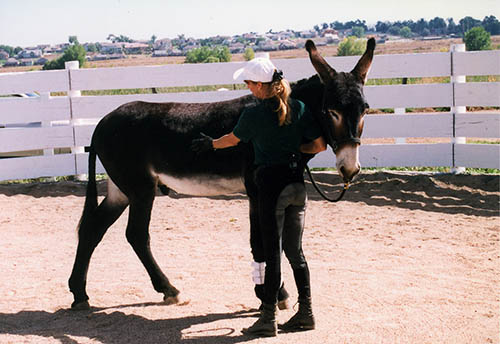 When he is flawless with his leading training, you can get him used to the bridle and a surcingle or lightweight saddle, and then move on to ground driving. Lunging is not as important, since most donkeys do not like to lunge. I suppose they don’t see much purpose in going around in a circle more than once to come back to the same place over and over again. Taking the time to properly train your donkey jack at halter and in the drivelines will enhance his obedience, and will make him more comfortable and relaxed. During the breeding process, it can even speed up his readiness.
When he is flawless with his leading training, you can get him used to the bridle and a surcingle or lightweight saddle, and then move on to ground driving. Lunging is not as important, since most donkeys do not like to lunge. I suppose they don’t see much purpose in going around in a circle more than once to come back to the same place over and over again. Taking the time to properly train your donkey jack at halter and in the drivelines will enhance his obedience, and will make him more comfortable and relaxed. During the breeding process, it can even speed up his readiness.
When using your jack for breeding, develop a routine that he can count on every time. When you go to the stall or pen to catch the jack, wait for him to come to you at the gate or stall door, and then reward him with oats when he comes to you. Then put on the halter, ask him to take one step backwards, and then reward him again (which is very important to prevent him from running over you and barging through the gate or out the door). If you are going to breed him, the mare should first be prepared. Next, once you are both out the door, ask him to whoa and square up all four feet. Then you can lead him to the breeding area, where you can then tie him to the hitch rail a little ways away from the waiting mare. By being consistent in your manner of going from the stall to the breeding area, the jack will learn not to be pushy and aggressive toward you.
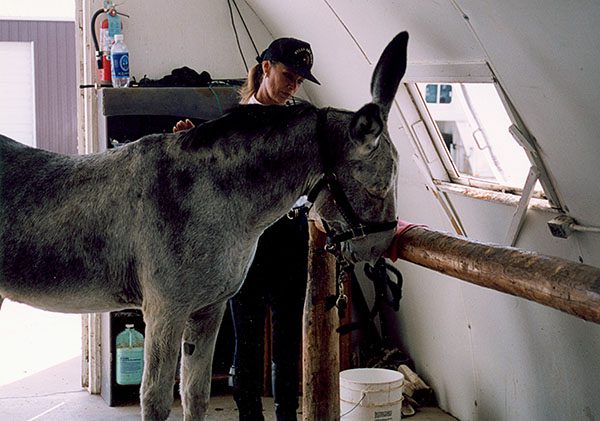 When in the breeding area, your jack must be taught patience and obedience. If the mare is left to stand just out of reach until he is ready to breed, he may consider this a tease and may become anxious and unruly. To clarify your intentions to him, you can take the cloth you used to clean the mare and place it over the hitch rail near your jack’s nose. This way, he can get a good, strong scent of the mare, which will more quickly ready him for breeding and substantially decrease his anxiety time. If he is an indifferent jack, this can actually increase his interest in the female and, in turn, shorten the actual breeding process time. The fact that you brought him the scent allows the jack to believe that it is your decision when to breed and not his and that he must remain obedient. Let him cover the mare only when he is fully ready and make him walk to her in a gentlemanly fashion. If he becomes too aggressive and starts to drag you just return him to his place on the hitch rail, hold him there for a minute, reward him when he stands still and then re-approach the mare.
When in the breeding area, your jack must be taught patience and obedience. If the mare is left to stand just out of reach until he is ready to breed, he may consider this a tease and may become anxious and unruly. To clarify your intentions to him, you can take the cloth you used to clean the mare and place it over the hitch rail near your jack’s nose. This way, he can get a good, strong scent of the mare, which will more quickly ready him for breeding and substantially decrease his anxiety time. If he is an indifferent jack, this can actually increase his interest in the female and, in turn, shorten the actual breeding process time. The fact that you brought him the scent allows the jack to believe that it is your decision when to breed and not his and that he must remain obedient. Let him cover the mare only when he is fully ready and make him walk to her in a gentlemanly fashion. If he becomes too aggressive and starts to drag you just return him to his place on the hitch rail, hold him there for a minute, reward him when he stands still and then re-approach the mare.
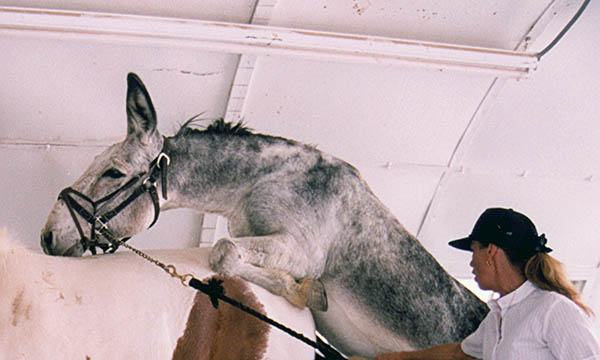 Just to be on the safe side with your jack while breeding, use either a muzzle or a dropped noseband (snugly fit low on his nose)—this will prevent biting injuries to you or to the mare. When he is finished, make him stand quietly behind the mare while you rinse him off. Allow him that last sniff to the mare’s behind, and then take him back to his stall (or pen), ask him to stand still while you remove the halter and then let him go. That last sniff appears to be an assertion of his act and of his manhood. If you try to lead him away before he sniffs, he might not come with you and he might become even more aggressive toward the mare. Remember to do things with your jack in a routine way, and always with safety in mind—this will allow him to relax and use the manners he has learned. NOTE: Women who are menstruating should never handle jacks or stallions during that particular time, since the scent can trigger aggressive and dangerous behaviors in these animals.
Just to be on the safe side with your jack while breeding, use either a muzzle or a dropped noseband (snugly fit low on his nose)—this will prevent biting injuries to you or to the mare. When he is finished, make him stand quietly behind the mare while you rinse him off. Allow him that last sniff to the mare’s behind, and then take him back to his stall (or pen), ask him to stand still while you remove the halter and then let him go. That last sniff appears to be an assertion of his act and of his manhood. If you try to lead him away before he sniffs, he might not come with you and he might become even more aggressive toward the mare. Remember to do things with your jack in a routine way, and always with safety in mind—this will allow him to relax and use the manners he has learned. NOTE: Women who are menstruating should never handle jacks or stallions during that particular time, since the scent can trigger aggressive and dangerous behaviors in these animals.
When you are around a jack, you must always be alert and know what he is doing at all times. A jack can be the most adorable, loveable, obedient guy in the world, but you must realize that his natural instincts can arise at any time and, although he may not do it intentionally, he can severely hurt you just the same. And when observing a jack from the other side of the fence, always remember that he can come over the top of that fence, teeth bared, so don’t ever turn your back to him or become complacent around him!
Lastly, when putting on or taking off any of his headgear, watch your fingers—when a jack knows the bit is coming, he often opens his jaws to meet it (with anticipation of the bit on a bridle), and your fingers can easily get in the way. Rather than a standard lead rope, it is advisable to use a lead shank with stallions and jacks for the best control. However, I discourage running the chain of a lead shank either through the mouth or over the nose. The correct position for a lead shank is under the jaw. Run the end of the chain through the ring on the near side of the halter noseband, then under the jaw, then through 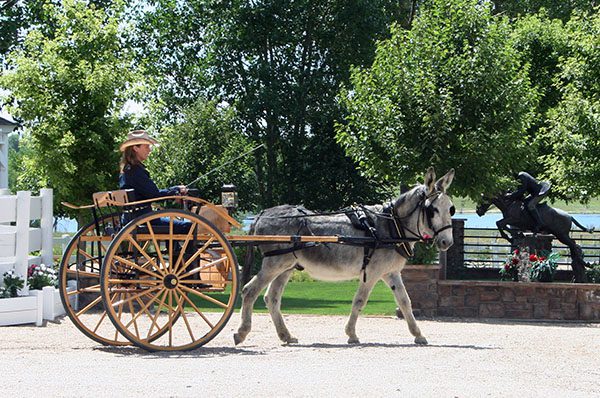 the ring on the opposite side of the noseband, and then clip it to the ring at the throatlatch on the right side of his face. This gives you enough leverage to control him without the halter twisting on his face. If you have spent plenty of time and done your homework during his leading lessons, your jack will learn to be obedient on the lead shank, even during breeding.
the ring on the opposite side of the noseband, and then clip it to the ring at the throatlatch on the right side of his face. This gives you enough leverage to control him without the halter twisting on his face. If you have spent plenty of time and done your homework during his leading lessons, your jack will learn to be obedient on the lead shank, even during breeding.
Retired jacks still need regular attention and proper maintenance to stay healthy into their senior years. Donkeys that do not receive good core muscle maintenance throughout their lives will often begin to sag drastically in the spine as they age. Their gait then becomes stilted, because their balance and strength are severely compromised. They can no longer track properly while moving or square up correctly when at rest. This can lead to irregular calcification in the joints, depression because they don’t feel well and premature health problems. On the other hand, the jack who has had a consistent and healthy management and training routine will enjoy longevity. If you keep these basic management and safety factors in mind, you and your jack can have a long, happy and mutually rewarding relationship!
To learn more about Meredith Hodges and her comprehensive all-breed equine training program, visit LuckyThreeRanch.com, MEREDITH HODGES PUBLIC FIGURE Facebook page, or call 1-800-816-7566. Check out her children’s website at JasperTheMule.com. Also, find Meredith on Pinterest, Instagram, MeWe, YouTube and Twitter.
© 1990, 2012, 2014, 2016, 2020, 2021, 2022, 2024 Lucky Three Ranch, Inc. All Rights Reserved.
